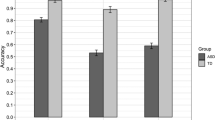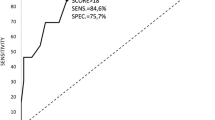Abstract
The objective of this study is to compare the cognitive profile, the motor and language functioning and the psychosocial adaptation of children with Asperger syndrome (AS) and with high-functioning autism (HFA). Subjects were recruited through the department Autism and Developmental Disorders of the Heckscher-Klinikum. To be included in the study, the full-scale-IQ had to be at least 80. Subjects with AS had to have a normal early language development and subjects with HFA a clear delay in language development, as reported by their parents. The sample consisted of 57 children with Asperger syndrome and 55 children with high-functioning autism. The mean age of the children was 10 years. All subjects were examined with a standardised test battery. Children with AS had a higher full-scale-IQ than children with HFA. This was due to a higher verbal-IQ. There were no significant differences in the performance-IQ. At a mean age of 10 years, subjects with AS had better language skills than subjects with HFA, but at least 30% showed clear receptive language problems. Motor problems were present in about 50% of the children with AS and HFA. The level of psychosocial adaptation was clearly reduced, but was comparable for the two groups. The differences in verbal-IQ and language skills between the two groups could be explained through the definition of the syndromes. The presence of language problems in the subjects with AS at age 10, the comparable degree of motor impairment and level of psychosocial adaptation question the validity of the distinction between AS and HFA within the category of pervasive developmental disorders.
Similar content being viewed by others
References
Asperger H (1944) Die autistischen Psychopathien im Kindesalter. Archiv Psychiatr Nervenkr 117:76–136
Eisenmajer R, Prior M, Leekam S, Wing L, Ong B, Gould J, Welham M (1998) Delayed language onset as a predictor of clinical symptoms in pervasive developmental disorders. J Autism Dev Dis 28:527–533
Elben C, Lohaus A (2000) Marburger Sprachverständnistest für Kinder (MSVK). Hogrefe, Bern
Ehlers S, Gillberg C (1993) The epidemiology of Asperger syndrome: a total population study. J Child Psychol Psychiatry 34:1327–1350
Fox A (2007) Test zur Überprüfung des Grammatikverständnisses (TROG-D). Schulz-Kirchner, Idstein
Ghaziuddin M, Mountain-Kimchi K (2004) Defining the intellectual profile of Asperger syndrome: comparison with high-functioning autism. J Autism Dev Dis 34:279–284
Gilchrist A, Green J, Cox A, Burton D, Rutter M, Le Couteur A (2001) Development and current functioning in adolescents with Asperger syndrome: a comparative study. J Child Psychol Psychiatry 42:227–240
Gillberg I, Gillberg C (1989) Asperger syndrome: some epidemiological considerations-a research note. J Child Psychol Psychiatry 30:631–638
Grimm H, Schöler H (1978) Heidelberger Sprachentwicklungstest (HSET). Hogrefe, Göttingen
Howlin P (2003) Outcome in high functioning adults with autism with and without early language delays: Implications for the differentiation between autism and Asperger syndrome. J Autism Dev Dis 33:3–13
Kenworthy L, Black D, Wallace G, Ahluvalia T, Wagner A, Sirian L (2005) Disorganisation: the forgotten executive dysfunctions in high-functioning autism (HFA) spectrum disorders. Dev Neuropsychol 28:809–827
Klin A, Pauls D, Schultz R, Volkmar F (2005) Three diagnostic approaches to Asperger syndrome: implications for research. J Autism Dev Dis 35:221–234
Koyama T, Tachimori H, Osada H, Takeda T, Kurita H (2007) Cognitive and symptom profiles in Asperger syndrome and high-functioning autism. Psychiatry Clin Neurosci 6:99–104
Lord C, Rutter M, Le Couteur A (1994) Autism Diagnostic Interview-Revised: a revised version of a diagnostic interview for caregivers of individuals with possible pervasive developmental disorders. J Autism Dev Dis 24:659–685
Lord C, Risi S, Lambrecht L, Cook E, Leventhal B, Dilavore P, Pickles A, Rutter M (2000) The Autism Diagnostic Observation Schedule-Generic: a standard measure of social and communication deficits associated with the spectrum of autism. J Autism Dev Dis 30:205–222
Mawhood L, Howlin P, Rutter M (2000) Autism and developmental receptive language disorder-a comparative follow-up in early adult life. I: cognitive and language outcomes. J Child Psychol Psychiatry 41:547–559
Manjiviona J, Prior M (1995) Comparison of Asperger syndrome and high-functioning autistic children on a test of motor impairment. J Autism Dev Dis 25:23–39
McAlonan G, Suckling J, Wong N, Cheung V, Lienenkämpter N, Cheung C, Chua S (2008) Distinct patterns of grey matter abnormality in high-functioning autism and Asperger’s syndrome. J Child Psychol Psychiatry 49:1287–1295
McAlonan G, Cheung C, Cheung V, Wong N, Suckling J, Chua S (2009) Differential effects on white matter systems in high-functioning autism and Asperger’s syndrome. Psychological Medicine 1-9 (Epub)
Noterdaeme M, Mildenberger M, Minow F, Amorosa A (2002) Evaluation of neuromotor deficits in children with autism and children with a specific speech and language disorder. Eur J Child Adolesc Psychiatry 11:219–225
Noterdaeme M, Mildenberger M, Sitter S, Amorosa A (2002) Parent information and direct observation in the diagnosis of pervasive and specific developmental disorders. Autism 6:159–168
Noterdaeme M, Kurz U, Mildenberger M, Sitter S, Amorosa A (1999) Ausschluß rezeptiver Sprachstörungen mittels des ADOS (Autism Diagnostic Observation Schedule). Z Kinder Jugendpsychiatr Psychother 27:251–257
Ozonoff S, South M, Miller J (2000) DSM-IV-defined Asperger syndrome: cognitive, behavioral and early history differentiation from high-functioning autism. Autism 4:29–46
Ozonoff S, Rogers S, Pennington B (1991) Asperger’s syndrome evidence of an empirical distinction from high-functioning autism. J Child Psychol Psychiatry 3:1107–1122
Remschmidt H, Schmidt M, Poustka F (2001) Multiaxiales Klassifikationschema für psychsiche Störungen des Kindes- und Jugendalters nach ICD-10. 4. Auflage. Huber, Bern
Rinehart N, Bradshaw J, Moss S, Brereton A, Tone B (2001) A deficit in shifting attention present in high-functioning autism but not in Asperger’s disorder. Autism 5:67–80
Saulnier C, Klin A (2007) Brief report: social and communication abilities and disabilities in higher functioning individuals with autism and Asperger syndrome. J Autism Dev Dis 37:788–793
Steinert J (1978) ADST Allgemeiner Deutscher SprachtestADST. Westermann, Braunschweig
Szatmari P, Bartolucci G, Bremner R (1989) Asperger’s syndrome and autism: comparison of early history and outcome. Dev Med Child Neurol 31:709–720
Tantam D (1988) Asperger’s syndrome. J Child Psychol Psychiatry 29:245–255
Tewes U, Schallberger P, Rossman U (1999) HAWIK-III Hamburg-Wechsler-Intelligenztest für Kinder. Huber, Bern
Tewes U (1984) HAWIE-R: Hamburg-Wechsler Intelligenztest für Erwachsene-Revision. Huber, Bern
Wing L (1981) Asperger’s syndrome: a clinical account. Psychol Med 11:115–129
Wing L (2000) Past and future of research on Asperger syndrome. In: Klin A, Volkmar F, Sparrow S (eds) Asperger syndrome. Guildford, New York, pp 418–432
World Health Organization (1991) Internationale Klassifikation psychischer Störungen. ICD-10 Kapitel V (f). Dilling H, Monbour W, Schmidt M. Huber, Bern
Author information
Authors and Affiliations
Corresponding author
Rights and permissions
About this article
Cite this article
Noterdaeme, M., Wriedt, E. & Höhne, C. Asperger’s syndrome and high-functioning autism: language, motor and cognitive profiles. Eur Child Adolesc Psychiatry 19, 475–481 (2010). https://doi.org/10.1007/s00787-009-0057-0
Received:
Accepted:
Published:
Issue Date:
DOI: https://doi.org/10.1007/s00787-009-0057-0




